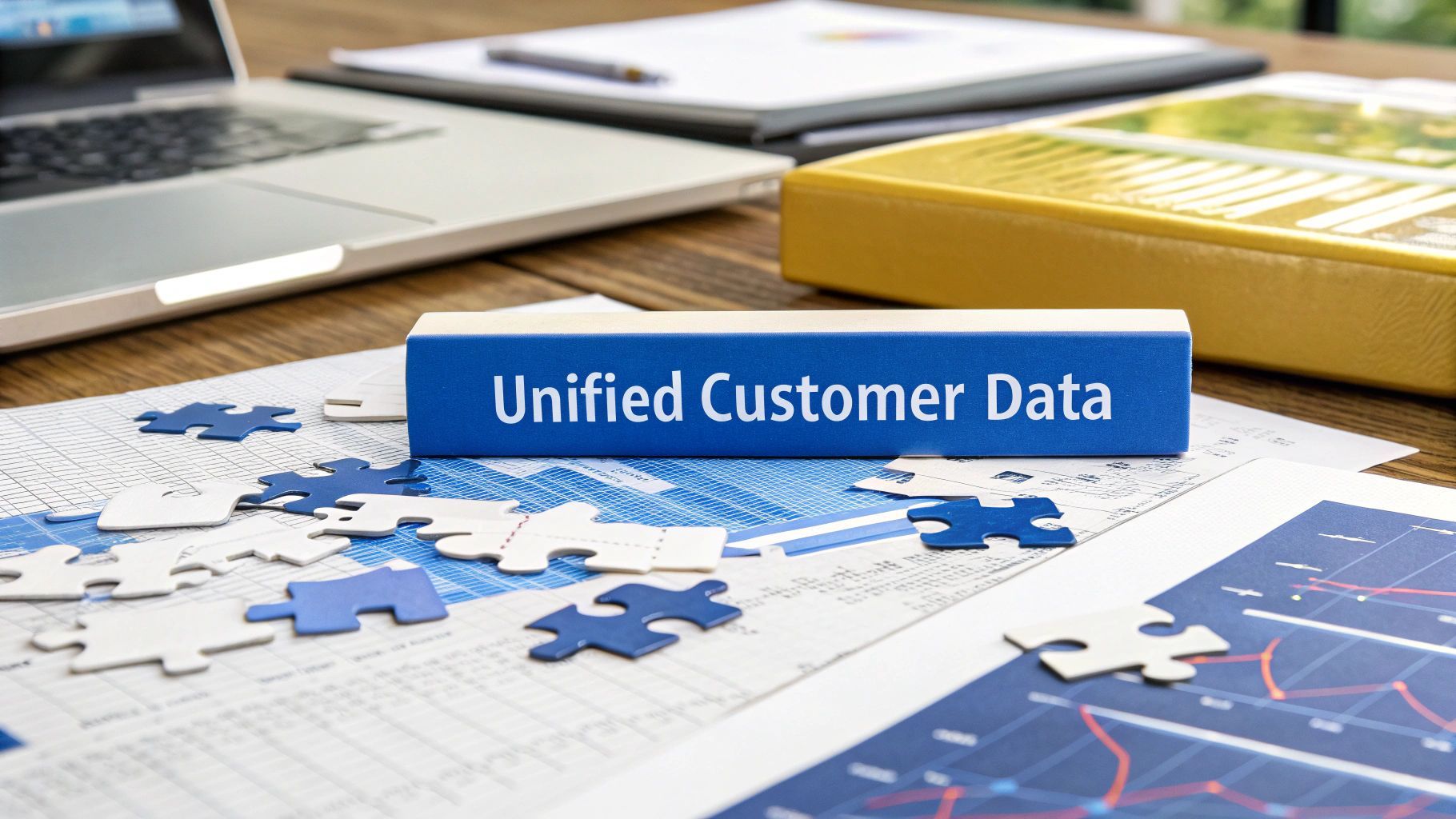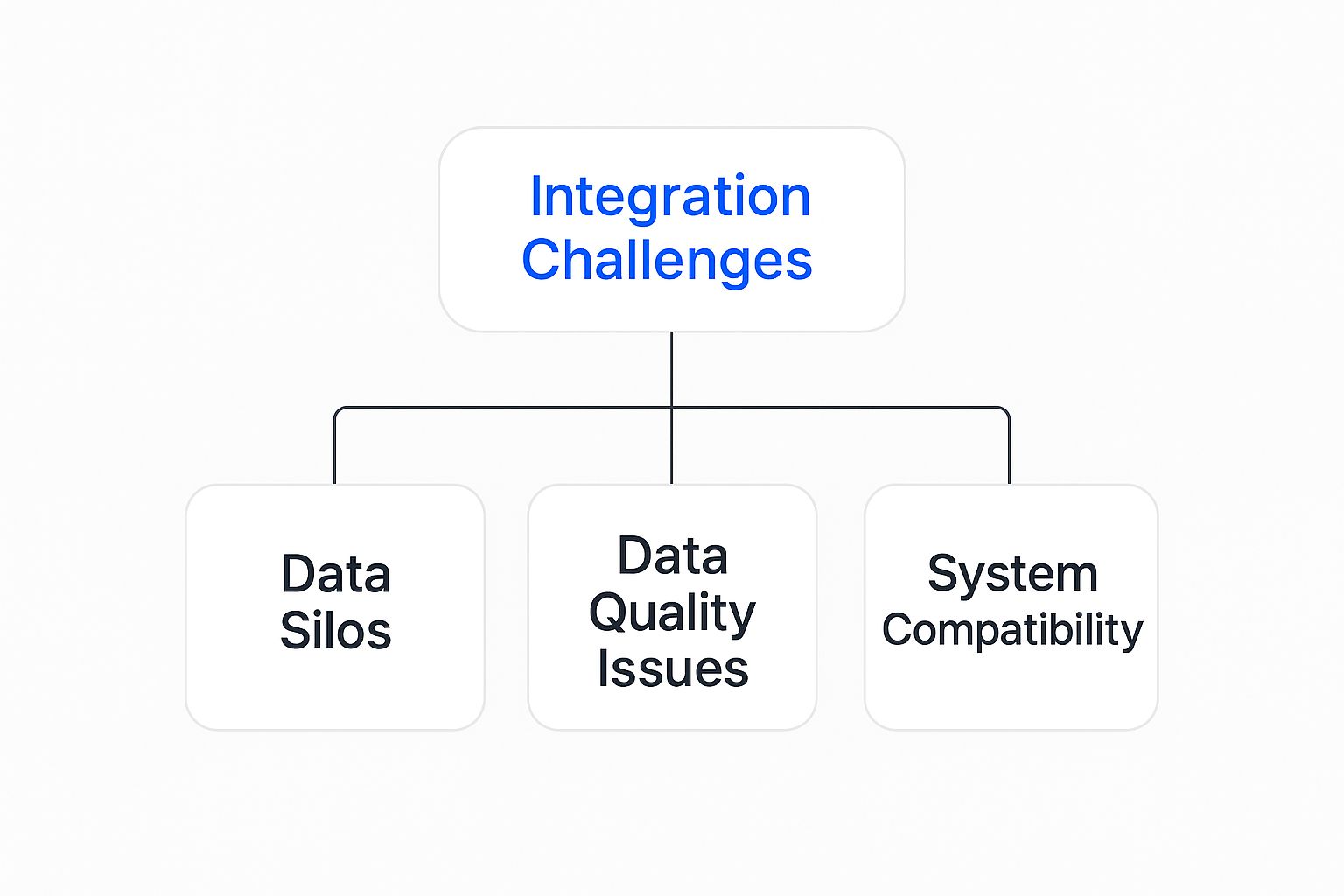
Unlocking Your Unified Customer Data Integration
Discuss with AI
Get instant insights and ask questions about this topic with AI assistants.
💡 Pro tip: All options include context about this blog post. Feel free to modify the prompt to ask more specific questions!
At its core, customer data integration (CDI) is all about bringing together every piece of information you have about a customer from all your different systems into one single, understandable profile. Think of it like a detective building a case file. You've got witness statements from your support team, transaction records from your sales system, and website activity logs from marketing. Individually, they're just clues. Together, they form a complete picture that lets you truly understand your customer.
This complete profile is the key to unlocking smarter marketing, more personal service, and real strategic growth.

Imagine trying to build a friendship with someone, but you're only allowed to know what they had for breakfast. It would be an awkward, shallow, and pretty useless conversation. That's exactly what many businesses do every day. Their customer information is trapped in separate, disconnected systems, leaving them with a fractured view of the people they serve.
Your marketing team knows about website clicks, the sales team has notes in the CRM, and your support reps are looking at service tickets. Each department is holding just one piece of the puzzle. Without a bridge to connect them, you never see the full picture of the customer. This siloed approach is a direct path to frustrating experiences, missed sales, and wasted effort.
When your data lives in separate silos, you simply can't see the whole story. This is how you end up sending a cheerful "Rate our service!" email to a customer who just had a terrible support experience. It’s how a high-value client might fly under the radar because their big purchases are logged in one system while their frequent engagement is tracked in another.
This disconnection isn't just a minor annoyance; it's a major strategic weakness. It creates friction for the customer and makes it impossible to deliver the seamless, personalized interactions people now expect. It actively holds back your growth and can even damage your brand's reputation.
This is where customer data integration steps in and becomes a true business superpower. CDI acts as the central hub, pulling all those scattered pieces of information together and merging them into one coherent, actionable profile for each customer.
By creating this unified view, you shift from making educated guesses to acting on genuine insight. Every touchpoint, from the first ad they saw to their most recent purchase, adds color and detail to a living profile of who your customers are and what they really need.
This rich, comprehensive profile becomes the bedrock for nearly every positive outcome you want for your business. It allows you to:
- Personalize your messaging with startling accuracy.
- Anticipate customer needs before they even ask.
- Equip support agents to resolve issues faster and more effectively.
- Make confident, data-backed decisions about everything from product strategy to marketing spend.
The clear need for these capabilities is why the global data integration market is booming. Valued at roughly USD 15.22 billion in 2025, it's expected to surge to USD 25.69 billion by 2029. This growth isn't just hype; it's driven by the very real challenge businesses face in taming their complex data environments to get at the insights within. You can learn more about the rapid growth of the data integration market to see the trend for yourself.
In the end, customer data integration isn't just another IT project. It’s a foundational business strategy that centers your entire organization on the one thing that matters most: your customer.

So, you’ve put in the work to pull all your scattered customer information into one place. What happens next? In the real world, the impact of a solid customer data integration strategy is huge, and it hits your bottom line directly. Think of it as the difference between shouting into a faceless crowd and having a personal, meaningful conversation with each individual.
The most powerful, immediate change is the ability to create hyper-personalized marketing that people actually appreciate. Imagine sending a loyal customer a special offer for something that perfectly complements their last three purchases. That’s a world away from sending them a generic discount for an item they already bought a month ago. This kind of relevance only happens when your marketing tools have the full picture.
A unified view turns your marketing from a bunch of disconnected shots in the dark into a single, cohesive customer journey. You can shape content, recommend products, and time offers based on a person’s complete history with your brand, not just their last click.
For a support agent, a unified customer view is the ultimate tool. When a customer calls with an issue, the agent doesn't have to grill them with repetitive questions or put them on hold to check three different systems. Everything they need to know is right there on one screen.
Let's play out a common scenario. A customer calls about a delayed delivery. The support agent can instantly see:
- Their entire purchase history and how much they've spent with you.
- The support ticket they just submitted through your website's chatbot.
- The marketing email they clicked on yesterday.
Armed with all this context, the agent doesn't just solve the delivery problem. They can acknowledge the customer's loyalty, reference their other recent interactions, and turn a frustrating moment into a positive one. This is how you build real trust. Problems get resolved in minutes, not hours, and your first-contact resolution rates will thank you for it.
A McKinsey study found that personalization can lift revenues by 5-15% and boost marketing spend efficiency by 10-30%. This isn't just about warm, fuzzy feelings; it's about using data intelligently to drive real financial growth.
Guesswork is a costly habit. Without integrated data, leaders are often forced to make big decisions using incomplete or contradictory reports. The marketing team might be celebrating a spike in engagement from a campaign, while the sales team is scratching their heads over a dip in conversions during that same period. Who has the right story?
With customer data integration, both teams are looking at the same trusted data. This gives leaders a clear, 360-degree view of how the business is actually performing and how customers are really behaving.
This single source of truth helps you confidently answer the most important questions:
- Which marketing channels are actually bringing in our most valuable, long-term customers?
- What product features do our highest-spending customers love most?
- Where are the friction points in the customer journey that are causing people to leave?
This clarity allows you to put your resources where they’ll have the biggest impact and steer the company with precision. It’s about seeing the direct line between your actions and the results. To learn more, check out our guide on how to increase customer lifetime value, because integrated data is what makes those lasting relationships possible.
Ultimately, this strategic insight is one of the most powerful long-term benefits of getting your data house in order. It's how you build a resilient, customer-focused business that's ready for anything.
Turning the concept of a unified customer profile into reality means you need a solid game plan. The right strategy for customer data integration really comes down to what you're trying to achieve, what technology you already have, and how fast you need that data to be available. Think of it like building a network of roads to connect different cities—some routes are best for heavy cargo moved on a schedule, while others are high-speed freeways for immediate travel.
Before we jump into modern tools, it helps to understand the foundational methods businesses have relied on for years. They provide some great context for why newer approaches are so popular today.
One classic method is ETL (Extract, Transform, Load). It’s a very structured process where data gets pulled from a source system (like your sales CRM), cleaned up and reshaped into a standard format, and then loaded into a central data warehouse. This is a workhorse, perfect for creating organized reports for business intelligence and analytics.
A close cousin is ELT (Extract, Load, Transform). The names are similar, but the process is flipped. With ELT, raw data is loaded first into a destination like a data lake, and only transformed later when you need it for a specific analysis. This approach offers a lot more flexibility and is fantastic at handling the massive volumes of unstructured data that are so common today.
While ETL and ELT are powerful, they were designed for an era before real-time personalization was the name of the game. Today's need for instant customer context called for a whole new kind of engine. And that’s where the Customer Data Platform (CDP) enters the picture.
A CDP isn't just another database. It's a purpose-built system designed to master the art of customer data integration. Its entire mission is to:
- Collect data from every place a customer interacts with you—your website, mobile app, CRM, support desk, and even physical stores.
- Stitch that data together using smart identity resolution to build a single, reliable profile for each person.
- Activate that unified profile by sending it back out to all the tools your teams rely on, like your email platform, ad networks, and customer support software.
This continuous loop of collecting, unifying, and activating data is what makes a CDP so incredibly effective. It's the modern command center for creating and maintaining that elusive single customer view.
The global CDP market, a key part of the customer data integration world, was valued at USD 7.4 billion in 2024 and is projected to skyrocket to USD 28.2 billion by 2028. This explosive growth underscores just how critical these platforms have become for any business serious about creating data-driven customer experiences.
Choosing the right method can feel overwhelming, so here’s a quick breakdown of these common approaches to help you see where each one shines. This table compares these strategies, highlighting what they're best for, along with their main pros and cons.
Approach Best For Pros Cons ETL Business intelligence and historical reporting. Highly structured and reliable for analytics. Slow, batch-based process; not suitable for real-time needs. ELT Handling large volumes of raw, unstructured data. Flexible, scalable, and preserves raw data for future use. Can be complex; requires transformation skills at the point of analysis. CDP Creating a unified customer profile for marketing and personalization. Purpose-built for customer data; enables real-time activation. Can be a significant investment; focused specifically on customer data. APIs Real-time, point-to-point data exchange between two systems. Instantaneous data sharing; highly flexible for specific tasks. Can become complex to manage many individual connections (point-to-point).
Ultimately, the best strategy often involves a mix of these tools. A CDP can serve as the central hub, with APIs providing the real-time connections and ETL/ELT handling large-scale data warehousing in the background.
Working alongside CDPs, Application Programming Interfaces (APIs) are the essential glue holding a modern integration stack together. An API is simply a messenger that allows different software applications to talk to each other in real time.
For example, when a customer starts a chat on your website, an API can instantly fetch their entire order history from your e-commerce platform and deliver it to the support agent's screen. This immediate data exchange is what makes seamless customer experiences possible. Our guide on CRM WhatsApp integration is a perfect example of how APIs bridge the gap between communication channels and core customer records.
The image below really drives home the common challenges that these strategies are built to solve.

As you can see, the biggest hurdles—data silos, poor data quality, and incompatible systems—are precisely what a smart integration strategy is designed to knock down.
To truly get this right, it's also worth looking into specialized solutions, like integrating directly with powerful marketing platforms like Marketo, which can give you a major leg up. The right blend of a central platform like a CDP and flexible API connections gives you both a strong foundation and the agility you need to adapt. By carefully choosing your mix of these strategies, you’re not just unifying data—you’re building a system that makes that data immediately useful across your entire company.

While everyone agrees a single view of the customer is the goal, the road to getting there is rarely smooth. Let's be honest: any ambitious data project will hit some bumps. Customer data integration isn't just about plugging in new software; it's about untangling old habits and navigating organizational politics.
Anticipating these challenges is half the battle. If you know what's coming, you can build a strategy to steer right around them. Let's look at the three biggest hurdles I see teams face time and time again, and more importantly, how to clear them.
The most common and frustrating obstacle is the data silo. This is what happens when different departments—marketing, sales, customer support—all operate in their own little kingdoms, with their own tools and their own data. Marketing has its campaign analytics, sales lives in the CRM, and support has its ticketing system, and none of them talk to each other.
This creates a completely fractured picture of the customer. It's why a loyal client might get a sales email pitching a product they just spent an hour on the phone complaining about to support. It’s a classic, and entirely avoidable, sign of siloed data.
The Solution: Create a Data Governance Team
Tearing down these walls requires a cultural shift, not just a technical one. The most effective approach is to create a cross-functional data governance team. This isn't just for the IT folks; it needs leaders and key players from every single department that touches customer information.
Their core mission is to:
- Define a unified vision for how customer data should be collected, managed, and used across the entire company.
- Set clear, consistent rules and quality standards that everyone agrees to follow.
- Champion collaboration and keep everyone focused on the real prize: a single, reliable customer profile.
Let's say you manage to connect all your systems. Great! But your project can still grind to a halt if the data itself is a mess. "Bad data" is the silent killer here—it's full of duplicate entries, typos, old phone numbers, and missing information.
Just think about it. How can you build one profile for a customer when you have three separate entries for "John Smith," "J. Smith," and "Johnathan Smyth"? They're all the same person. This kind of messy data poisons your analytics, makes personalization impossible, and ultimately erodes your team's trust in the entire system.
When your data is unreliable, every decision you make is built on a shaky foundation. Inaccurate information doesn’t just lead to poor outcomes; it actively works against your goals, making it harder to deliver the excellent service you’re aiming for.
The Solution: Automate Cleansing and Set Standards
You need a two-pronged attack to fight bad data. First, bring in tools for automated data cleansing and deduplication. Modern platforms can use AI to intelligently spot and merge duplicate records, fix formatting issues, and even fill in missing details.
Second, you have to establish strict data entry standards for everyone. This means training your teams on the right way to input information and making key fields mandatory wherever you can. It’s a proactive strategy that stops bad data from getting into your system in the first place, saving you countless hours of cleanup later. You can see how this plays a role in our guide on customer support automation, a process that absolutely depends on clean, integrated data to work.
In an era of GDPR and CCPA, data privacy isn't just a good idea—it's the law. These regulations come with strict rules about how you collect, store, and use personal information. One misstep can lead to crippling fines and a major blow to your brand's reputation.
A central challenge in customer data integration is making sure your new, unified profile respects every customer's consent and privacy choices across all channels. If someone unsubscribes from a marketing email, that preference has to be updated everywhere, instantly. No excuses.
The Solution: Build Privacy into the Design
The only way to manage this complexity is to treat privacy as a foundational element of your project, not an afterthought. This principle is often called "Privacy by Design."
In practice, this means your integration platform must be able to:
- Track and manage customer consent from a central hub.
- Quickly process data access or deletion requests from customers.
- Keep all data securely encrypted, whether it's sitting in a database or moving between systems.
When you're choosing your tools, look for platforms that are explicitly built to be GDPR-compliant and have rock-solid security features. By building your system on a foundation of privacy, you not only protect your business but also earn invaluable, long-lasting trust from your customers.
Picking the right technology for your customer data integration strategy is a make-or-break decision. You're not just buying another piece of software; you're investing in the central nervous system of your entire customer experience. The right tools will empower your teams and scale as you grow. The wrong ones? They’ll become a frustrating—and expensive—bottleneck.
Instead of just running through a list of popular platforms, let’s walk through a practical framework for how to actually evaluate them. This will help you ask the right questions and land on a solution that truly fits your business, both for today and for where you're headed.
Before you even book your first demo, your team needs to get on the same page about what "good" looks like. While every business has its own unique needs, a few criteria are non-negotiable.
Here’s a simple checklist to get you started. For any tool you consider, ask:
- Scalability: Can this platform handle our current data volume? Even more importantly, can it keep up as we grow over the next two or three years? You don't want to outgrow your investment.
- Ease of Use: Is the interface intuitive enough for our marketing and support teams to actually use, or will they need a dedicated engineer holding their hand? The goal is to empower people, not create dependencies.
- Connectivity: How well does it play with the tools we already use every day? Look for pre-built, reliable connectors for your essential systems, like your CRM, e-commerce platform, and marketing automation software.
This kind of forward-thinking is essential. The market for these tools is growing fast, particularly in certain regions. North America, for example, held about 40.15% of the global data integration market revenue in 2024. The U.S. market alone was valued at roughly USD 4.31 billion in 2024 and is on track to hit USD 14.20 billion by 2034, all thanks to companies jumping on innovative solutions early. You can dig into more of these global data integration market trends to see where things are headed.
One of the first major forks in the road you'll encounter is whether to build a custom integration solution from the ground up or buy a ready-made platform, like a Customer Data Platform (CDP). Each path comes with its own set of trade-offs that go way beyond the initial price tag.
Building a custom solution offers ultimate control. You can craft a system that fits your unique business logic like a glove. But that control comes at a steep price: a massive upfront investment in engineering talent, time, and resources. The real gotcha, though, is the hidden cost of long-term maintenance, security updates, and bug fixes, which can quietly drain your budget and distract your team for years.
Buying a platform like a CDP gets you to the finish line much faster. These tools are purpose-built for integrating customer data, giving you powerful features like identity resolution, audience segmentation, and data activation right out of the box. Yes, there's a subscription cost, but it's often a fraction of the total cost of ownership you’d face with a custom build.
For most businesses, the "buy" approach simply makes more sense. It lets you focus your team's energy on using the data to create amazing customer experiences, rather than getting bogged down in building and maintaining the plumbing.
At the end of the day, the right tool is the one that best matches your business goals, your team's technical skills, and your budget.
A great way to approach this is to create a simple scorecard based on the criteria we discussed. Rank each potential solution, and make sure to pull in key people from marketing, sales, customer support, and IT. Getting everyone involved ensures you’ll have their buy-in when it’s time to roll it out.
By taking a structured, criteria-first approach, you can cut through the marketing noise and make an investment that will pay dividends for years to come.
Even when you see the potential, getting started with customer data integration can bring up some practical questions. Let's walk through a few of the most common hurdles to clear the path forward.
This is a classic point of confusion, and for good reason. It helps to think about what kind of relationship each platform manages.
- A CRM (Customer Relationship Management) system is all about your direct, one-to-one interactions. Think of it as your digital rolodex for known customers, tracking things like sales calls, support tickets, and email history.
- A DMP (Data Management Platform) lives in the world of anonymous data, primarily for advertising. It deals in cookies and device IDs to group people into broad audiences for ad campaigns.
- A CDP (Customer Data Platform) is the master connector. It’s built to pull in every kind of customer data—from the anonymous web visitor to the loyal, known customer—and stitch it all together into one single, persistent profile for each person.
A CDP doesn't replace your CRM or DMP; it makes them work smarter. By feeding them a complete, trustworthy customer profile, the CDP ensures every tool you use has the best possible information to work with.
You don't need a massive, all-at-once project. The smart move is to start small and score a quick win. Focus on connecting just two of your most important data sources first.
For example, a great first step is integrating your e-commerce platform with your CRM. Suddenly, your team can see a customer's entire purchase history right next to their support tickets, which is a game-changer for service quality. Another simple but powerful move is linking your website analytics to your email marketing tool. This lets you send personalized emails based on what someone was just looking at on your site.
AI is the engine that makes modern customer data integration truly powerful. It automates the heavy lifting that used to be incredibly difficult and slow.
A key area where AI shines is identity resolution—the tricky process of figuring out that "Jen Smith," the email "jsmith@email.com," and a specific phone all belong to the very same person. Beyond that, AI can analyze all your newly connected data to find patterns, like predicting which customers might be about to leave or who is most likely to buy again. It turns your data from a simple record of the past into a crystal ball for the future.
Ready to unify your customer data and automate your support? Spur uses AI to connect your channels and create seamless experiences. Start your free 7-day trial today.
